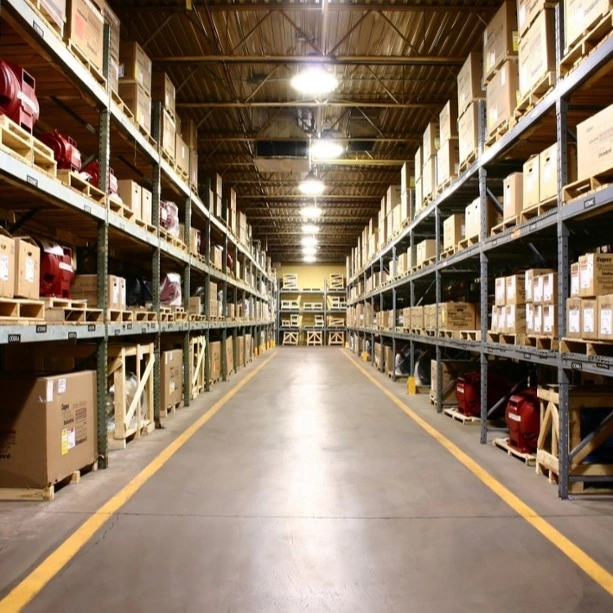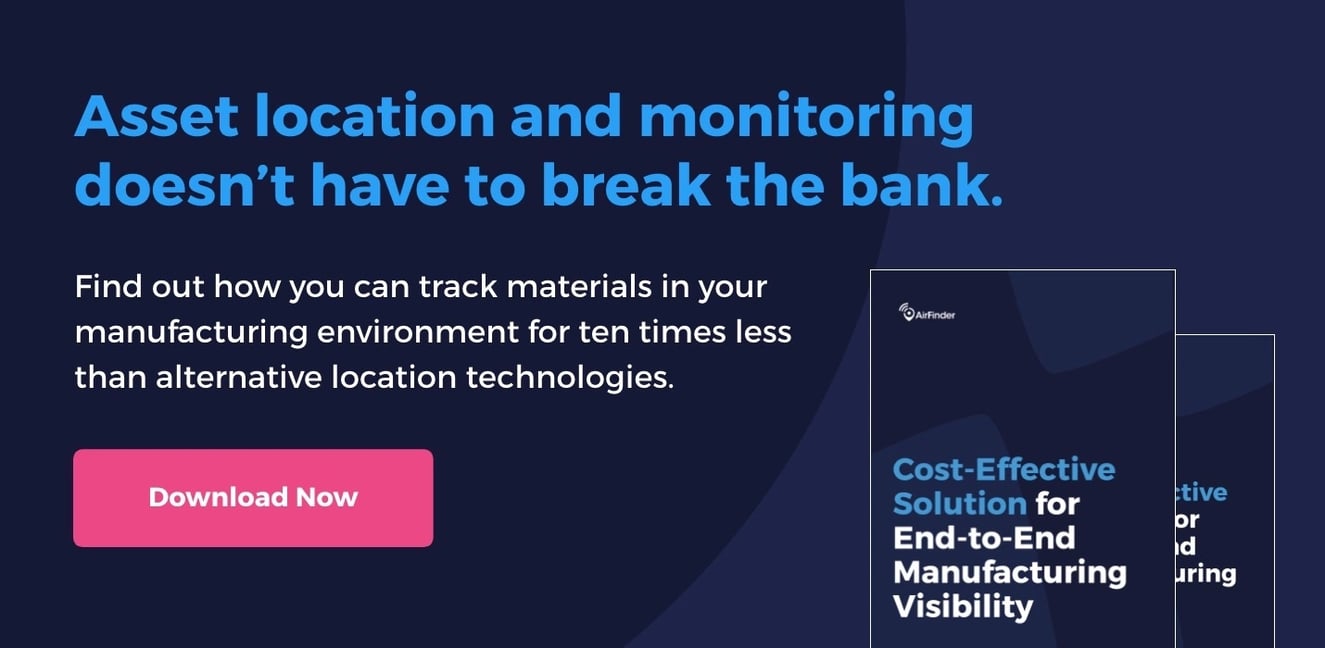Whether you’re in manufacturing, retail, distribution, or shipping, planning and managing the flow of raw materials and finished goods through your supply chain is a challenge. Materials are often improperly shipped or stored, which can damage sensitive goods. Plus, the sheer size and capacity of a large operation can lead to disorganization in a manufacturing warehouse or distribution facility.
One of the best ways to decrease material waste and improve logistics is with the use of real-time location systems (RTLS).
Download this free whitepaper to learn how large scale manufacturing operations track and monitor materials in their plants.
In the past, supply chain tracking and monitoring solutions—like ultra wide-band (UWB) and infrared technologies—required significant infrastructure, which came with a major installation headache and a significant price tag (often $10 per square meter). Today, there are asset-tracking solutions on the market, like AirFinder, that can be installed and operated for 10 times less than UWB and infrared.
Before we get into more details as to what you should look for when selecting a supply chain management IoT solution, let’s look at several use cases of IoT applications in logistics.
Location Tracking
1. Track deliveries from the vendor to the manufacturing facility.If you work with numerous U.S. vendors to create a single component for your device—say, a network of sheet metal vendors for an auto manufacturer—RTLS can be used to track pallets of this component from every vendor, from the time the pallets are packed until the time they enter your manufacturing yard. This way you’ll know well ahead of time if a shipment is delayed, allowing you to keep production running smoothly with your “Plan B.”
2. Track deliveries and materials around your manufacturing facility.Truck drivers have little to no incentive to ensure your goods are delivered precisely where you’ve instructed, which often leads to lost or misplaced shipments. If you use RTLS, you’ll know precisely where pallets have been placed.
3. Track deliveries and materials inside your manufacturing facility.Materials moved inside a facility for assembly or shipping often fall prey to what we call the “flat spot problem”—e.g. being left on any flat surface available. Misplaced materials can lead to slower production times, employee frustration, and, ultimately, customer dissatisfaction. With RTLS you know the location of tagged materials, like a specialty test fixture, at all times.
Environment Sensing
4. Monitor sensitive goods to avoid damage or loss.Some factories regularly receive shipments of perishable or sensitive goods that only stay fresh for a short time, and/or require specific environmental conditions to maintain quality.
Using an IoT application for logistics, you can tag a crate of eggs or a barrel of milk and monitor the humidity in the storage area, the temperature of the product, and the shock and vibration levels these items experience during shipment. You can use this information to notify truck drivers of damaged shipments long before they arrive at your factory, and get a new shipment on its way.
Fleet Management
5. Monitor assets to mitigate risk.If you’re involved in the transport of goods from point A to point B, you need to know where your vehicles are at all times for safety and compliance reasons. Without a tracking system, it can become easy to make erroneous assumptions. For example, you might assume that Bob is with his assigned vehicle—but what if he took a different vehicle that day? Or what if that vehicle is in the shop and he’s in another, and you’re simple unaware? This type of tracking system allows you to ensure you know where each vehicle in your fleet is so you can hold up your end of the supply chain.
6 Questions To Ask Before Selecting An IoT Application For Logistics & Supply Chain Management
1. What level of accuracy does the system allow for?Do you need room-level accuracy, or more specific location capabilities? This will make a difference in the kind of system you select. For some systems (like AirFinder), a higher number of reference points can be added to increase location accuracy.
2. How much infrastructure is required?If you’re building new construction, systems like infrared or WiFi-based RTLS may work well for you. But if you’re retrofitting a system in your current building, you’ll want to select RTLS that is easier to install.
3. What is the total cost of ownership?The total cost of ownership is one of the most important considerations for manufacturers looking to implement an IoT-based monitoring and tracking solution. Battery life, tag cost, power consumption, and employee training all come into play when calculating cost, so evaluate them all when considering a solution.
4. How much does each tag cost?Tag cost varies dramatically. Passive RFID tags can be pennies on the dollar, Bluetooth low energy (BLE) tags can be obtained for less than $15, and WiFi tags are typically around $40-$60. The tag cost, of course, makes an impact on whether or not an IoT-based logistics solution will work for you or not.
5. How long is the battery life for each tag?Battery life impacts affordability and maintenance. AirFinder tags, for instance, do not beacon continually, so they last up to three times as long as traditional BLE tags.
6. Is the system secure?When you implement an IoT application of any sort on your network, keeping your data secure is a top priority. The AirFinder system uses multiple layers of device and data security to ensure your data and IT networks are safe. BLE data is encrypted end-to-end using modern AES TLS data transport methods. A “stand-alone” data network, which can be connected via cellular, eliminates IT network vulnerability.
Meet AirFinder: A Smarter Supply Chain Management Solution
AirFinder is an intelligent RFID solution that uses reference point BLE beacons placed throughout your facility. These devices provide location information to tagged assets. AirFinder tags—attached to any item you want to track or monitor—“wake up” at certain intervals and check to see if they’ve been moved. If they have, they send out their updated location. If not, they go back to sleep. Once location information is received by the gateway, it is sent to the cloud. This approach to supply chain tracking means that tags last longer, location accuracy increases, and the latency of location updates is minimized.
If you’d like to learn more about AirFinder, take a look at our product page or download the white paper below. You’ll learn how large-scale manufacturing operations track and monitor materials in their plants, and how you can get started tracking, too.





